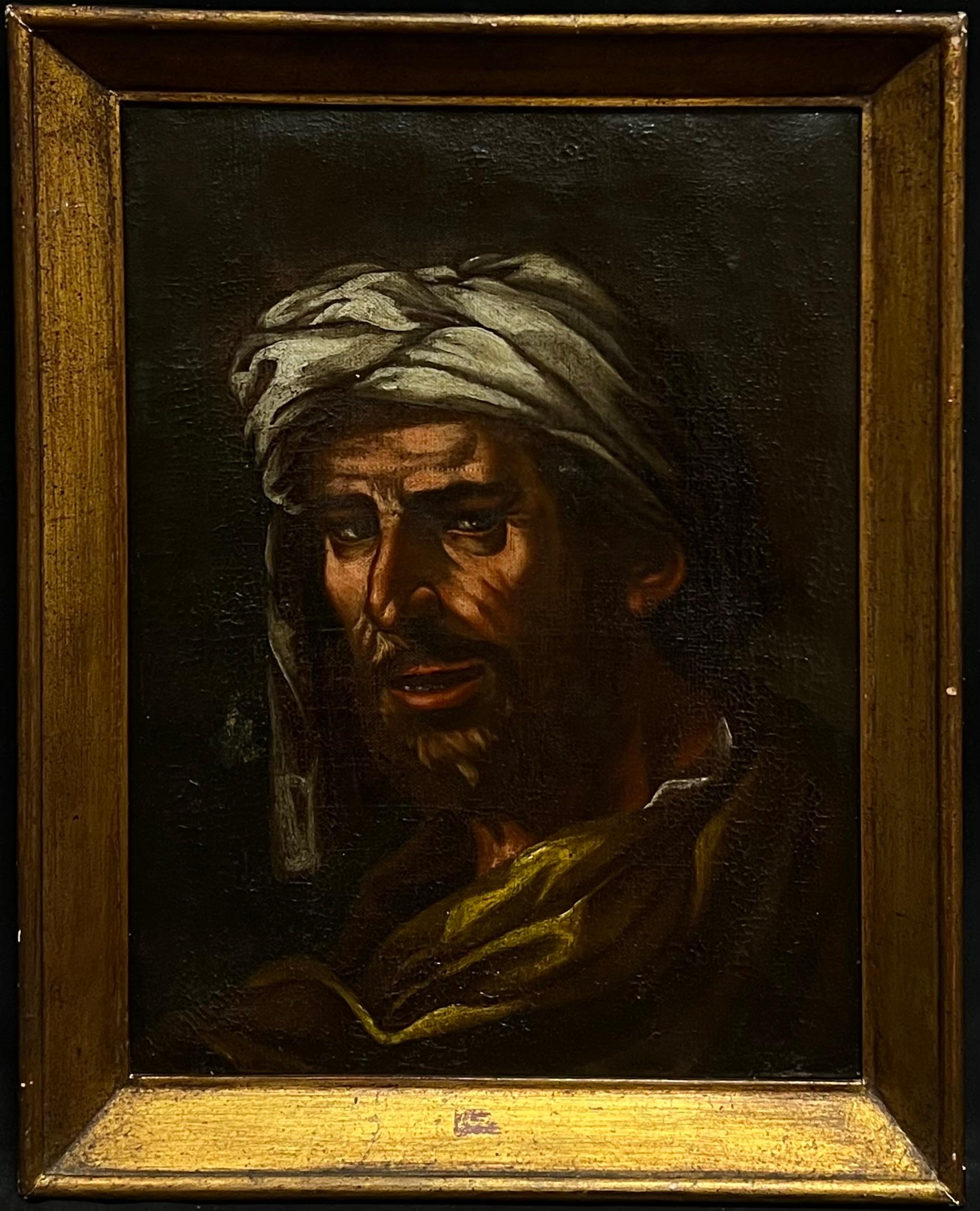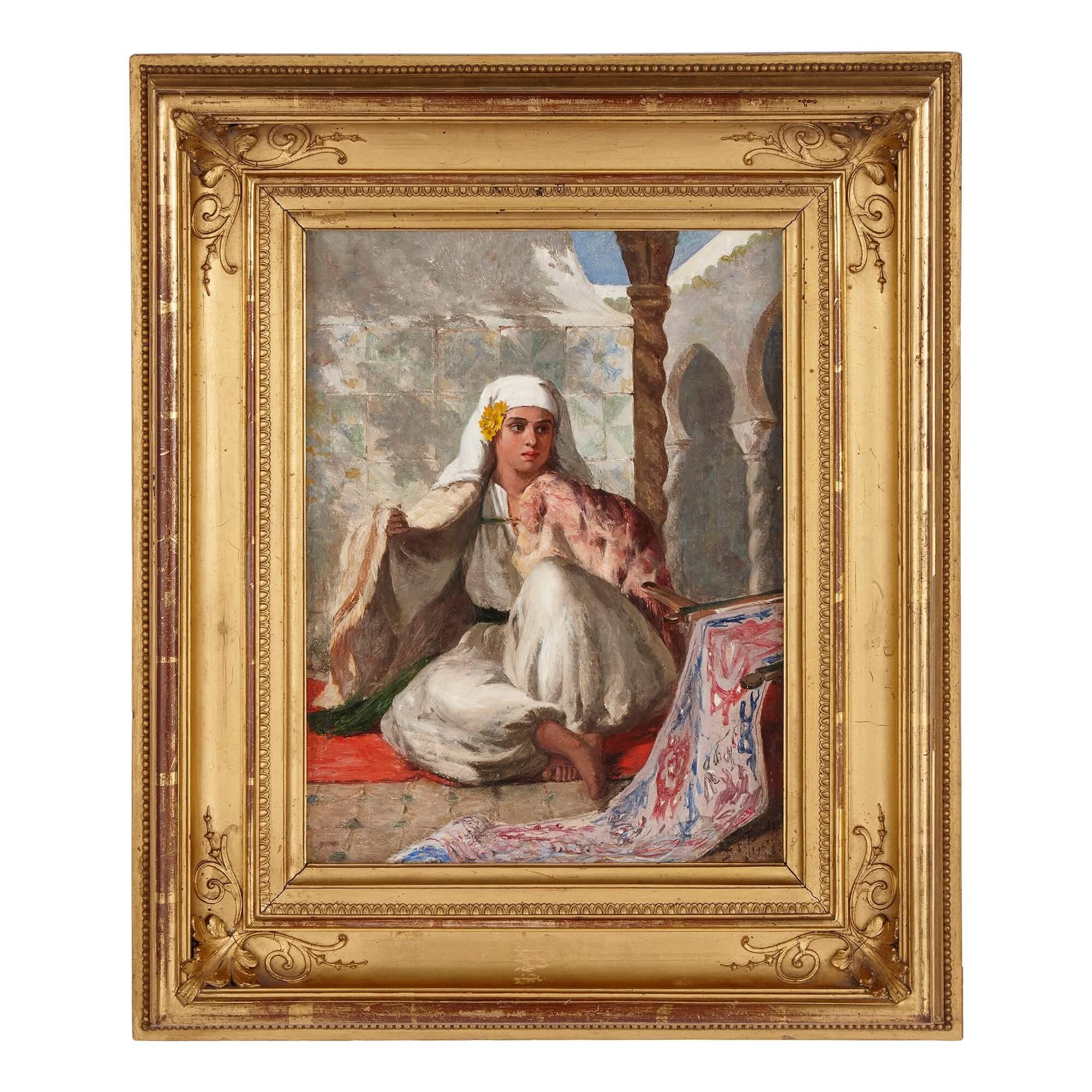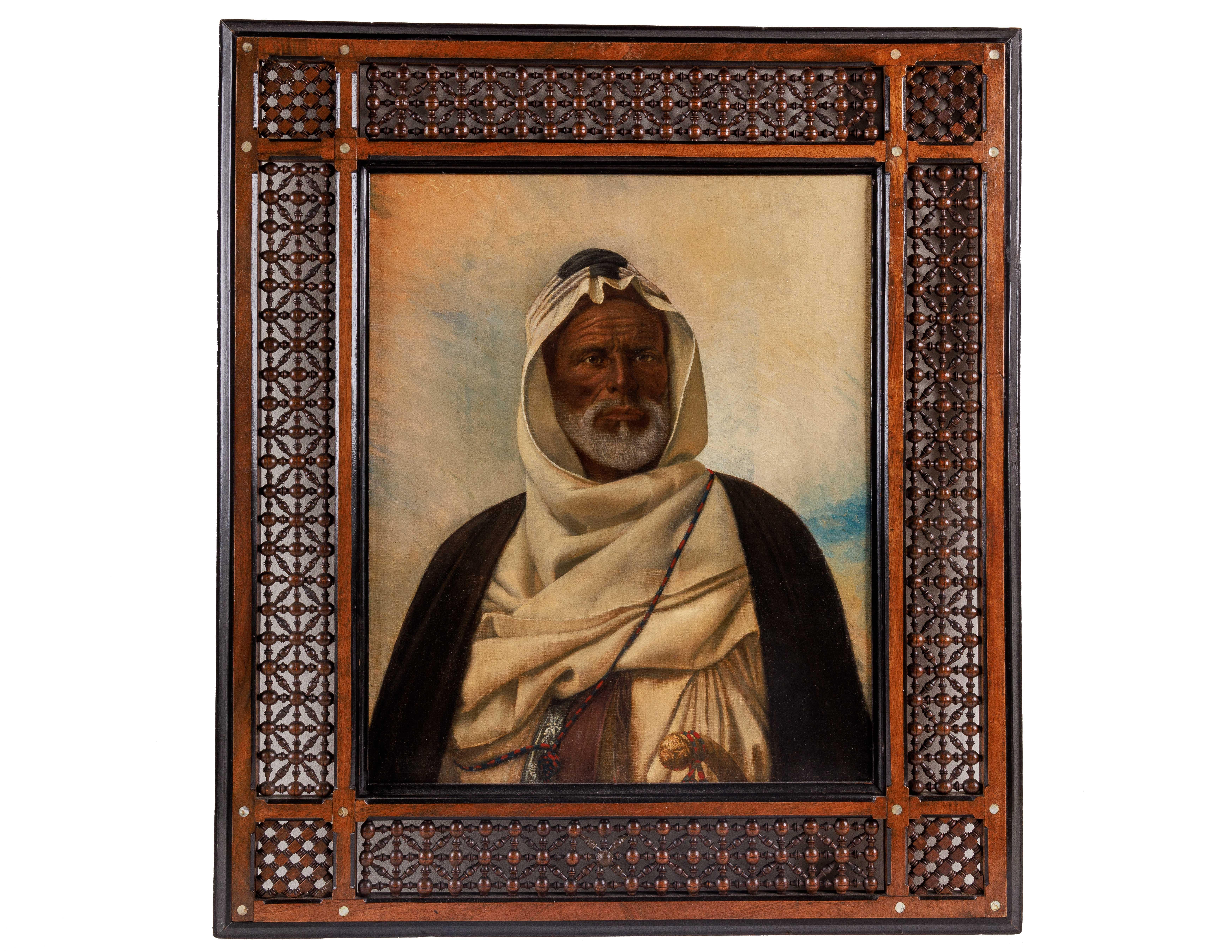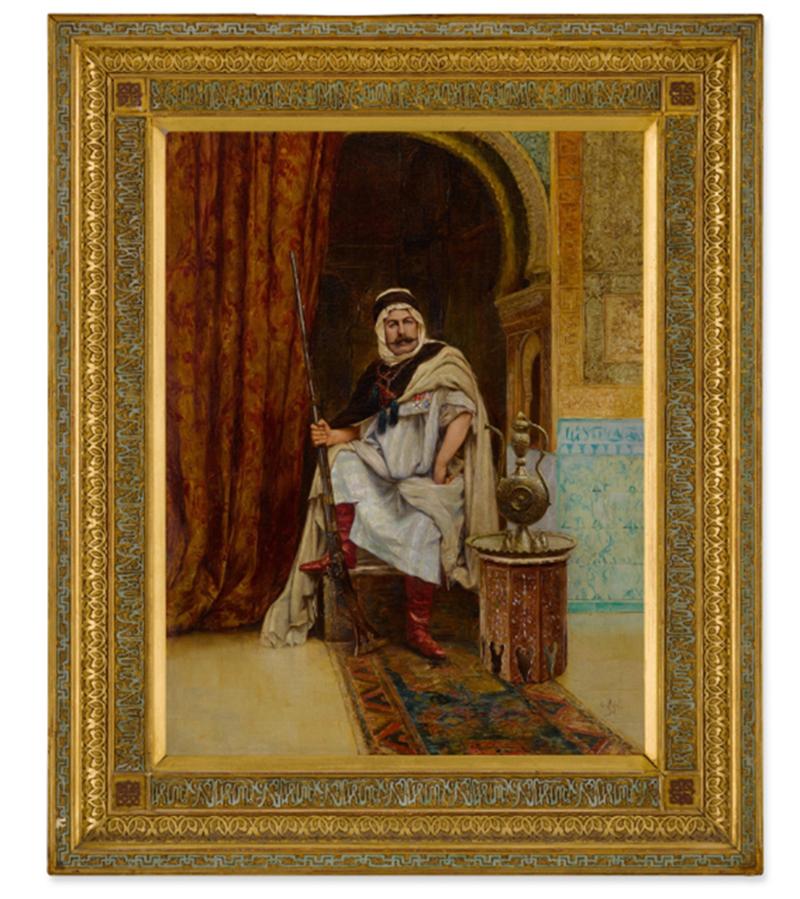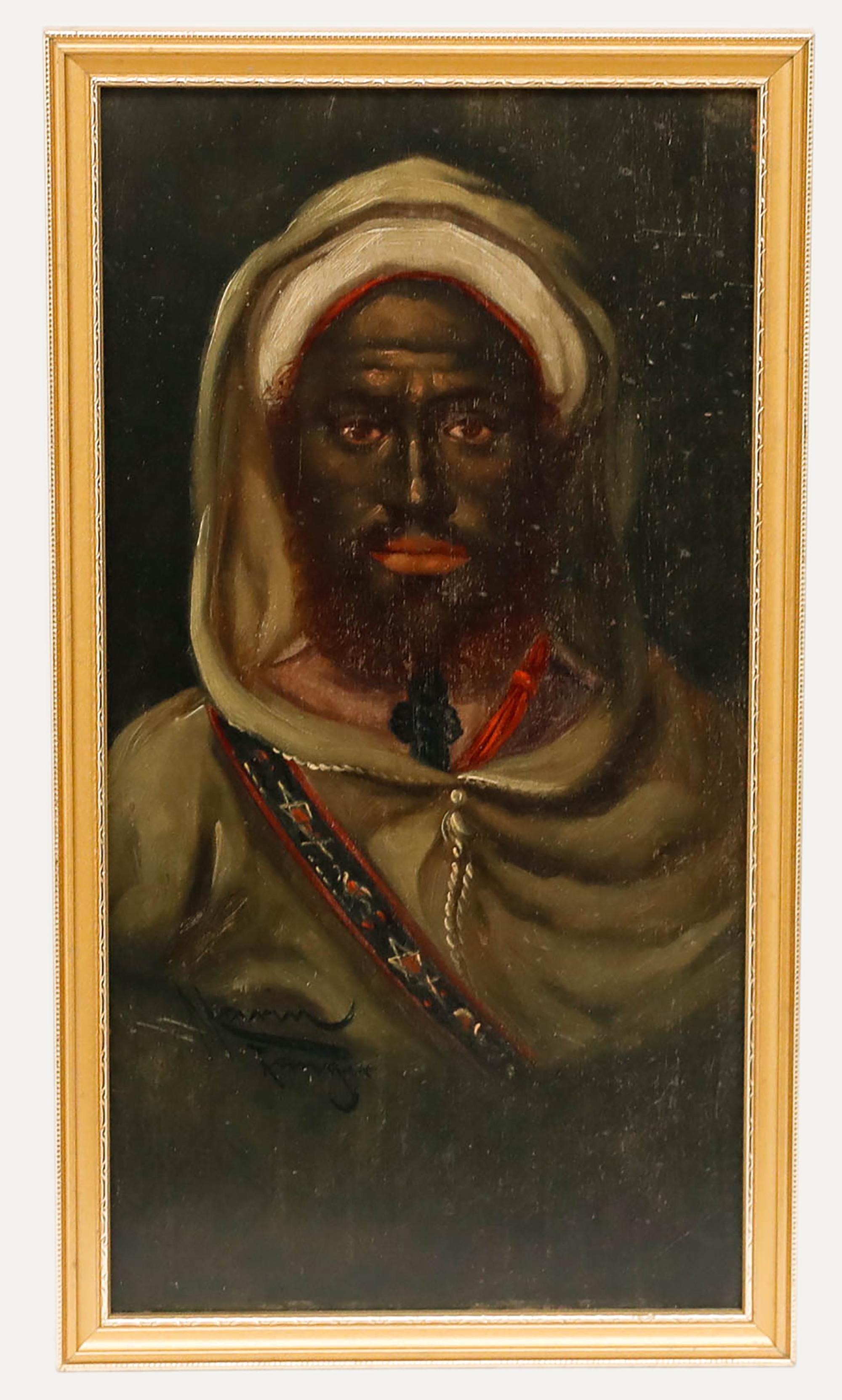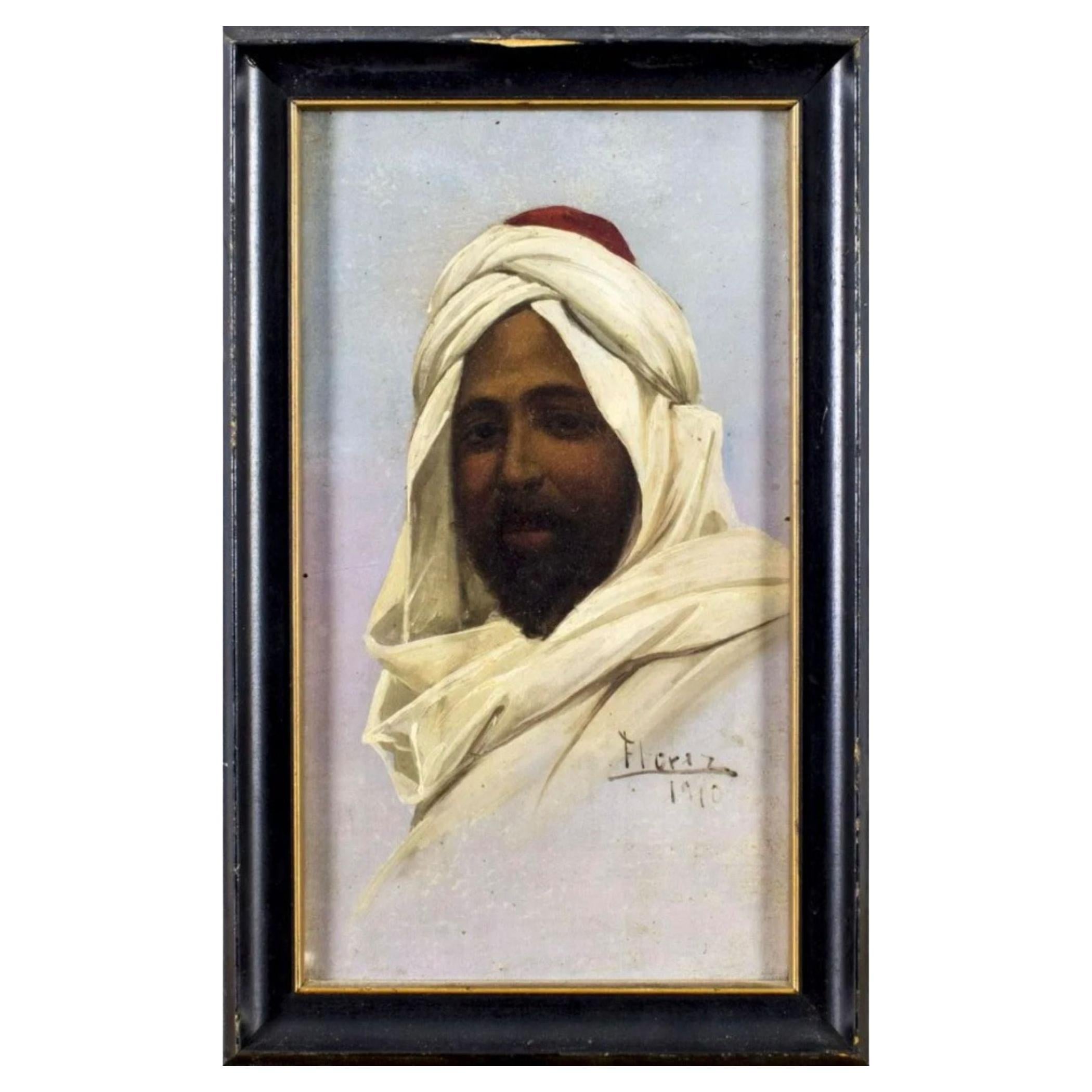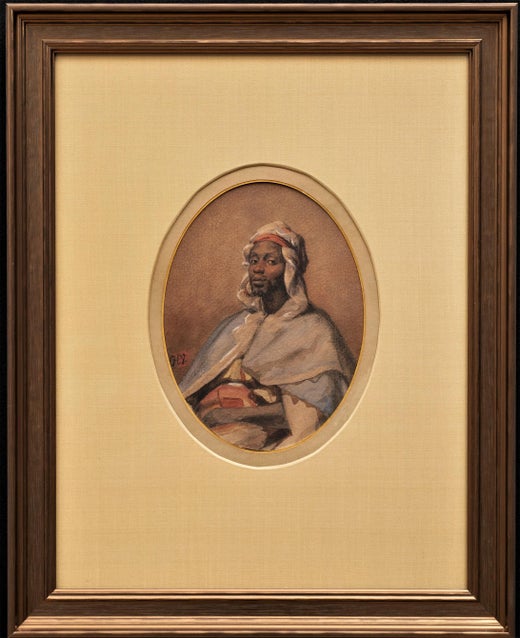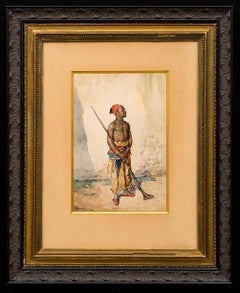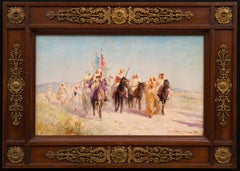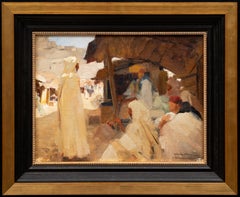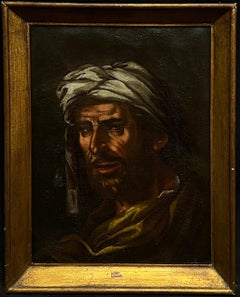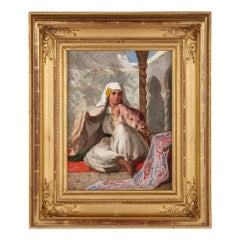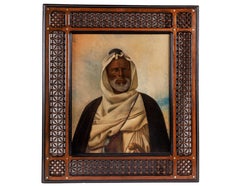Items Similar to “Orientalist Portrait of an Arab Man” Jean-Horace Vernet (French 1789-1863)
Video Loading
Want more images or videos?
Request additional images or videos from the seller
1 of 11
Émile Jean-Horace Vernet“Orientalist Portrait of an Arab Man” Jean-Horace Vernet (French 1789-1863)
$18,500
£14,047.49
€16,064.35
CA$25,847.18
A$28,747.71
CHF 15,011.16
MX$349,829.04
NOK 191,715.43
SEK 179,795.25
DKK 119,894.41
Shipping
Retrieving quote...The 1stDibs Promise:
Authenticity Guarantee,
Money-Back Guarantee,
24-Hour Cancellation
About the Item
“Orientalist Portrait of an Arab Man”
Half-length, turned to the left, oval
Jean-Horace Vernet (French 1789-1863)
Circa 1830s
Watercolor heightened with touches of white on paper
Signed with initials 'H.V.' lower left
Ex. collection Dr Simon Lee
Horace Vernet was born in Paris in 1789 and was predestined for art by his family heritage of well-known and accomplished artists.
Vernet was France's foremost painter of land and seascapes, he was casually trained by his father, Carle Vernet, and his grandfather Joseph Vernet. A child prodigy, having become a professional by his teens he was spurred by financial needs to exploit his phenomenal natural gifts arising from his early marriage in 1811. A torrent of saleable work soon poured from his studio: fashion designs, caricatures, portraits, and landscapes.
In 1814 he was among the civilian defenders of Paris against the approaching allied nations, an episode he later represented in La Barrière de Clichy (1820, Louvre).
In the early years of the Restoration, his studio became the meeting place of artists and veterans, filled with political intrigue, openly hostile to the Bourbon government. Much to that government's irritation, he flaunted his cult of Napoleon and found a patron in Louis-Philippe, duc d'Orléans, head of the disaffected cadet branch of the dynasty. A resolute modernist but little affected by romanticism, he befriended Gericault and was one of the Pioneers of lithography.
In a series of battle scenes from the Revolutionary and Napoleonic Wars, Jemmapes, Montmirail, Hanau, and Valmy, painted for the duc d'Orléans in 1821-1826 (National Gallery, London), he gave a foretaste of what was to become his specialty.
Paintings he created were seen to be rather conciliatory to the government, which were gratefully received. These pieces began producing positive and prompt results. In short order thereafter, he was made an officer of the Legion of Honor (1825), a member of the Institute (1826), and after successes at the Salons of 1826 and 1827 was appointed director of the French Academy in Rome (1829). During his seven years there, he displayed an agile versatility with paintings of Italian popular life (The Brigand's Confession), oriental subjects (The Arab Storyteller), and historical anecdotes (Encounter of Raphael and Michelangelo in the Vatican).
The Revolution in July 1830, which raised Louis-Philippe, Vernet's patron, to the throne, opened vast opportunities of official employment to him. The rapid flow of state commissions for battle pieces that now came his way taxed even his prodigious facility. Four very large canvases for the Galerie des Batailles at Versailles, shown at the Salon of 1836, were followed by a second series in 1841. Accepting his calling as that of a painter of modern national subjects, specifically of scenes of combat, Vernet conceived of his work as a form of eyewitness reportage that required observation at the actual theaters of war. In five long visits to North Africa (1833, 1837, 1839-1840, 1845, 1853), he gathered on-the-spot documentation of the French conquests in Algiers and Morocco, material that he later worked up into wall-size canvases destined for Versailles. Louis-Philippe's overthrow by the Revolution of 1848 and the advent of Napoleon III in 1849 scarcely affected his activity. The year 1850 found him at the French siege of Rome; in 1854 he visited the battlefields of the Crimea. He had in the meantime enjoyed the lucrative patronage of Czar Nicholas I during two long visits to Russia in 1836 and 1842-1843.
The Universal Exposition of 1855, at which he was represented by twenty-four paintings, crowned his popular and official success. His reputation among artists and critics, on the other hand, was not uncontested. Baudelaire scathingly referred to him as "un militaire qui fait de la peinture," and while his painstaking factuality and the sheer magnitude of his production commanded respect, the prosy shallowness of his realism, his stylistic banality, and the stridency of his chauvinism were early noted and contributed to the eventual neglect of his work.
At the time of his death in 1863, Vernet, a member of thirty academies, was nevertheless France's most famous artist, admired and imitated throughout Europe and deeply embedded in popular culture.
Public collections include briefly;
Rijksmuseum, MFA Houston, Krakow, LACMA, Cleveland, Met, British, Getty, Baltimore, etc...
- Creator:Émile Jean-Horace Vernet (1789 - 1863, French)
- Dimensions:Height: 18 in (45.72 cm)Width: 14 in (35.56 cm)
- Medium:
- Movement & Style:
- Period:
- Condition:This painting is in very fine condition. Beneath the linen mat, is the original passepartout cut mat with lines created with ink made from walnuts.
- Gallery Location:SANTA FE, NM
- Reference Number:1stDibs: LU1408216155422
Émile Jean-Horace Vernet
Émile Jean-Horace Vernet was a French painter of battles, portraits, and Orientalist Arab subjects. He was born to Carle Vernet, another famous painter, who was himself a son of Claude Joseph Vernet. He was born in the Paris Louvre, while his parents were staying there during the French Revolution. Vernet quickly developed a disdain for the high-minded seriousness of academic French art influenced by Classicism, and decided to paint subjects taken mostly from contemporary culture. Therefore, he began depicting the French soldier in a more familiar, vernacular manner rather than in an idealized, Davidian fashion. Some of his paintings that represent French soldiers in a more direct, less idealizing style, include Dog of the Regiment, Trumpeter's Horse, and Death of Poniatowski. He gained recognition during the Bourbon Restoration for a series of battle paintings commissioned by the duc d'Orleans, the future King Louis-Philippe. Critics marvelled at the incredible speed with which he painted. Many of his paintings made during this early phase of his career were "noted for their historical accuracy as well as their charged landscapes." Examples of paintings in this style include his Four Battles series: The Battle of Jemappes (1821), The Battle of Montmirail (1822), The Battle of Hanau (1824), and The Battle of Valmy (1826). Over the course of his long career, Horace Vernet was honoured with dozens of important commissions. King Louis-Philippe was one of his most prolific patrons. His depictions of Algerian battles, such as the Capture of the Smahla and the Capture of Constantine, were well-received, as they were vivid depictions of the French army in the heat of battle. After the fall of the July Monarchy during the Revolution of 1848, Vernet discovered a new patron in Napoléon III of France. He continued to paint representations of the heroic French army during the Second Empire and maintained his commitment to representing war in an accessible and realistic way. He accompanied the French Army during the Crimean War, producing several paintings, including one of the Battle of the Alma, which was not as well received as his earlier paintings. One well known and possibly apocryphal anecdote maintains that when Vernet was asked to remove a certain obnoxious general from one of his paintings, he replied, "I am a painter of history, sire, and I will not violate the truth," hence demonstrating his fidelity to representing war truthfully. Vernet died in his hometown of Paris in 1863.
About the Seller
5.0
Platinum Seller
Premium sellers with a 4.7+ rating and 24-hour response times
Established in 1995
1stDibs seller since 2020
118 sales on 1stDibs
Typical response time: 1 hour
- ShippingRetrieving quote...Shipping from: Santa Fe, NM
- Return Policy
Authenticity Guarantee
In the unlikely event there’s an issue with an item’s authenticity, contact us within 1 year for a full refund. DetailsMoney-Back Guarantee
If your item is not as described, is damaged in transit, or does not arrive, contact us within 7 days for a full refund. Details24-Hour Cancellation
You have a 24-hour grace period in which to reconsider your purchase, with no questions asked.Vetted Professional Sellers
Our world-class sellers must adhere to strict standards for service and quality, maintaining the integrity of our listings.Price-Match Guarantee
If you find that a seller listed the same item for a lower price elsewhere, we’ll match it.Trusted Global Delivery
Our best-in-class carrier network provides specialized shipping options worldwide, including custom delivery.More From This Seller
View AllOrientalist "Moorish Soldier Holding a Rifle" Manuel Garcia Hispaleto
Located in SANTA FE, NM
"Moorish Soldier Holding a Rifle"
Manuel Garcia Hispaleto (Spanish, 1836-1898)
Watercolor on paper
Signed lower left "MGHispaleto"
Original wood frame with gilded stucco
18 3/4 x 12 1/2 (33 1/2 x 26 frame) inches
Manuel García Hispaleto, originally Manuel García y Martínez (22 November 1836, Seville -26 December 1898, Madrid) was a Spanish painter known for portraits and costumbrista (genre) scenes. His brother, Rafael García...
Category
1850s Realist Portrait Paintings
Materials
Watercolor, Handmade Paper
Orientalist Painting “Tuareg Rider in the Desert, 1908” Paul Jouve (1878-1973)
By Paul Jouve
Located in SANTA FE, NM
“Tuareg Rider in the Desert, 1908”
Paul Jouve (1878-1973)
Oil on panel, signed lower right.
21 ¾ × 17 1/2 ( 27 ½ × 24 frame) inches
Paul Jouve’s work has been celebrated and collect...
Category
Early 1900s Art Nouveau Animal Paintings
Materials
Oil, Wood Panel
Orientalist: "Arabian Horseman" dated 1903 André Chaumière
Located in SANTA FE, NM
"Fantasia of Arabian Horseman" dated 1903
André Chaumière (French, XlX-XX)
Oil on canvas
Handcrafted original wood frame with bronze applique
20 3/4 x 12 3/4 (28 1/2 x 20 frame) inc...
Category
Early 1900s Art Nouveau Figurative Paintings
Materials
Canvas, Oil
Orientalist Painting "Constantine (Algeria) 1893" Claude Firmin-Goy (1864-1944)
Located in SANTA FE, NM
Constantine (Algeria)
Claude Firmin-Goy (1864-1944)
Oil on canvas
Signed and dated lower right
11 3/4 x 15 1/2 (17 1/2 x 21 1/4 frame) inches
This bright and luminous work by the Av...
Category
1890s Art Nouveau Figurative Paintings
Materials
Canvas, Oil
"Portrait of The Sage" by Emin Abbasov (b. 1950, Azerbaijan), oil on cardboard
Located in SANTA FE, NM
"Portrait of The Sage"
Emin Abbasov (b. 1950, Azerbaijan)
Oil on cardboard, signed
4 7/8 x 3 1/2 (16 x 14 1/2 frame) inches
Emin Abbasov is classically ...
Category
21st Century and Contemporary Realist Portrait Paintings
Materials
Oil, Cardboard
Dog Portrait of a Grand Vendéen Hunting Dog Jules Chardigny (1849-1892) ca 1870s
Located in SANTA FE, NM
Dog Portrait of a Grand Vendéen Hunting Dog
Jules Chardigny (1849-1892)
Signed lower right
Circa 1870
Oil on wood panel
Housed within its beautiful and original ornate original gil...
Category
Mid-19th Century Realist Animal Paintings
Materials
Oil, Wood Panel
You May Also Like
18th Century French Orientalist Portrait of Arab Man in Turban, oil painting
Located in Cirencester, Gloucestershire
Portrait of Arab Man in Turban
French artist, 18th century
oil on canvas, framed
Framed: 21 x 16.5 inches
Canvas : 18.5 x 14 inches
Provenance: private collection, France
Condition: ...
Category
18th Century Old Masters Portrait Paintings
Materials
Oil, Canvas
Orientalist Portrait Painting by Bridell-Fox, 1865
Located in London, GB
Orientalist portrait painting by Bridell-Fox, 1865
English, 1865
Canvas: Height 33cm, width 25cm
Frame: Height 49.5cm, width 42cm, depth 6cm
This intimate portrait depicts a seated ...
Category
19th Century Portrait Paintings
Materials
Canvas, Wood, Oil
An Exceptional Quality Orientalist Portrait of "A Moorish Chief"
Located in Queens, NY
An Exceptional Quality Orientalist Portrait of "A Moorish Chief from Algeria", circa 1880.
Oil on canvas painting depicting a Moorish chief / gu...
Category
19th Century Portrait Paintings
Materials
Oil
Clemente Pujol de Gustavino An orientalist Arab Guardsman
Located in New York, NY
Artist: Clemente Pujol de Guastavino (1850-1905)
Origin: Spanish
Signature: signed C. Pujol (lower right)
Medium: oil on canvas
Dimension: 25 1/2 in x 19 3/4 in. Framed 34 by 2...
Category
19th Century Portrait Drawings and Watercolors
Materials
Canvas, Oil
Emile Marin (1876-1940) - Framed Oil, Portrait of a Bedouin Man
By Emile Marin
Located in Corsham, GB
An early 20th century Portrait of a Bedouin Man, oil on panel. Signed 'A. Marin' to the lower left. Well presented in an elegant gilt-effect frame. On panel.
Category
Early 20th Century Portrait Paintings
Materials
Oil
Alfredo Florez Gonzalez Antique Oil Painting "Portrait of Middle Eastern Man"
Located in Dallas, TX
ARTIST: Alfredo Florez Gonzalez (Spanish, 19/20 century)
TITLE: Portrait of Middle Eastern Man
YEAR: 1910
MEDIUM: oil on board
CONDITION: Few minor paint losses. No visible inpai...
Category
Vintage 1910s Paintings
Materials
Canvas
More Ways To Browse
Revolutionary War Art
Arab Art
Bourbon Sign
Antique Oval Portrait
Houston African Art
Duc Duc
Portrait Of Napoleon
Antique Advent
French Oval Portraits
Siege Antique
Raphael Paris Paintings
Galerie Half
Antique Spurs
Oval Italian Painting
Revolutionary War Antique
British Caricature
V De Maneer
Paintings Of Arab Scenes
